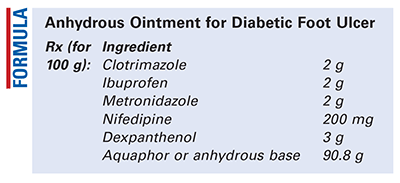US Pharm. 2018;43(10):59-60.

Method of Preparation: Calculate the quantity of each ingredient for the amount to be prepared. Accurately weigh or measure each ingredient. Reduce the powders to a relatively uniform particle size and mix together. Incorporate the Aquaphor (or other suitable anhydrous base) geometrically, with thorough mixing after each addition. Package and label.
Use: This preparation has been used in the treatment of foot ulcers resulting from diabetes.
Packaging: Package in a tight, light-resistant container.
Labeling: Keep out of reach of children. Discard after ____ [time period]. Protect from light. For external use only.
Stability: A beyond-use date of up to 6 months may be used for this preparation.1
Quality Control: Quality-control assessment can include theoretical weight compared with actual weight, specific gravity, active drug assay, color, texture–surface, texture–spatula spread, appearance, feel, rheologic properties, and physical observations.2
Discussion: Diabetes is one of the leading causes of death in the United States. It is associated with multiple health complications, including hypoglycemia, hypertension, dyslipidemia, stroke, eye problems, kidney disease, and amputations. Foot ulcers also occur in diabetes, and they can eventually lead to amputation unless they are treated. A number of preventive methods exist, including keeping the feet clean, wearing comfortable shoes, and performing regular foot examinations. In the case of wounds or ulcers, debridement and oral antibiotic therapy have been used, as well as topical application of compounded medications such as the one presented here.
Clotrimazole (Lotrimin, Mycelex, C22H17ClN2, MW 344.84) occurs as a white to pale-yellow, crystalline powder that melts at about 142°C with decomposition. It is freely soluble in alcohol and practically insoluble in water. Clotrimazole is an antifungal agent used topically and vaginally in the treatment of susceptible fungal infections.1,3
Ibuprofen (Motrin, C13H18O2, MW 206.28) is a nonsteroidal anti-inflammatory agent with analgesic and antipyretic activity. It is used in the treatment of inflammatory diseases (rheumatoid arthritis, juvenile arthritis, and osteoarthritis) and pericarditis and for the relief of mild-to-moderate pain. Ibuprofen occurs as a white to off-white, crystalline powder with a slight, characteristic odor. It is practically insoluble in water but is highly soluble in alcohol and acetone.1
Metronidazole (Flagyl, C6H9N3O3, MW 171.15) occurs as white to pale-yellow, odorless crystals or a crystalline powder. It is stable in air but will darken on exposure to light. Metronidazole is sparingly soluble in water and alcohol, but only slightly soluble in ether and chloroform. It is used as an antibiotic.1
Nifedipine (Adalat, Procardia, C17H18N2O6, MW 346.33) is a 1,4-dihydropyridine-derivative calcium-channel blocking agent used in the management of Prinzmetal variant angina and chronic stable angina pectoris, hypertension, Raynaud phenomenon, preterm labor, and acute myocardial infarction. It occurs as a yellow powder that is affected by exposure to light. It is practically insoluble in water and soluble in alcohol. In this formulation, it serves as a vasodilator to increase blood flow to the region.1,4
Dexpanthenol (C9H19NO4, MW 205.25) occurs as a clear, viscous, somewhat hygroscopic liquid, having a slight characteristic odor. It is freely soluble in water, alcohol, and propylene glycol and slightly soluble in glycerin. Some crystallization may occur upon standing. It should be stored in airtight containers. It has been used topically in 2% to 5% concentrations in the treatment of various minor skin disorders.5
Aquaphor is a stable, neutral, odorless, and anhydrous ointment base that is miscible with water or aqueous solutions, forming water in oil emulsions. It contains petrolatum, mineral oil, ceresin, and lanolin alcohol. Aquaphor is anhydrous, and if no water is present in the other ingredients, according to the USP, a beyond-use date of up to 6 months may be used.1,6
REFERENCES
1. U.S. Pharmacopeia/National Formulary [current revision]. Rockville, MD: U.S. Pharmacopeial Convention, Inc; September 2018.
2. Allen LV Jr. Standard operating procedure for performing physical quality assessment of ointments/creams/gels. IJPC. 1998;2:308-309.
3. MedlinePlus. Clotrimazole. https://medlineplus.gov/druginfo/meds/a682753.html. Accessed September 7, 2018.
4. McEvoy GK, ed. AHFS Drug Information 2016. Bethesda, MD: American Society of Health-System Pharmacists; 2016:2013-2020.
5. Sweetman SC, ed. Martindale: The Complete Drug Reference. 35th ed. London, England: Pharmaceutical Press; 2007:2142.
6. Aquaphor. www.aquaphorus.com. Accessed September 26, 2018.
To comment on this article, contact rdavidson@uspharmacist.com.






